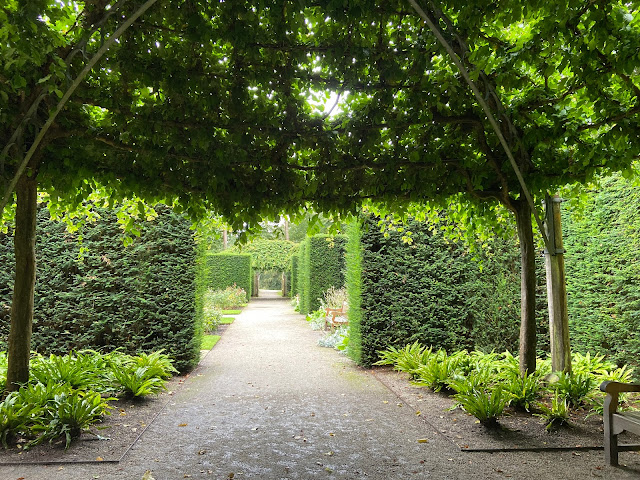The Gertrude Jekyll Long Border is designed to be at its best from July to August. I've written before about the design of the border and how its colour themes are based on those Gertrude Jeykll used at her own garden at Munstead Wood
here.
Back in June the border was dominated by pale blues and yellows. Look how it's changed. The dominant tones are now reds and oranges as the Dahlias, Phlox and Monardas begin to bloom.
 |
| Reds, oranges and yellows lead down to blue Eryngium |
 |
| The blue and pale yellow section of the Long Border |
The Delphinium Summer Skies are nearly over, but the colour theme is taken up by the lilac of the Campanula Lactiflora and the candy-floss pink flowers of the Filipendula Rubra 'venusta'. Blue foliage in the foreground is Iris Pallida and the blue grass Helictotrichon sempervirens. The hawthorn hedge behind this section of the border is a field hedge of some age, but a section had been removed from it. New hedging plants will fill in the missing section in time.
 |
| Pale yellow, stronger yellows and red dominated in this section |
In June this portion of the border was nearly empty of colour. Now the yellow flowers of the later summer are coming into full bloom. The tall spires in the centre of the picture above are the common Mullein. The front of the border is furnished by the handsome leathery leaves of Bergenia. These latter two plants were some of the very few growing in the garden when we moved here.
 |
| Dahlias and hollyhocks in the red and orange section |
The planting of this section is mainly in tender perennials and annuals. The Dahlias are a selection of red and orange varieties including Karma Naomi and Garden Wonder. At the front of the border are the annuals Nasturtium and Amaranthus caudatus 'Love lies bleeding'. I'm very taken by their long tassels like elephant's trunks which keep getting longer and longer until they lie on the ground. Also bedded out, but not making much of an impact yet are the Cannas. There is Canna indica 'Tropicana Black' with the dark leaf and Canna Brilliant which is green leafed. The green leafed plant seems to like it here and the tubers have increased year on year, so from the original five plants I now have about twenty. This hasn't happened with the dark leafed plant, where from the original three I now have only two.
 |
| The end of the Border cools down into pale yellow and blue |
As the border nears its end the colours cool down again. Here Calendula Snow Princess, pale yellow snapdragons and some white Cosmos provide colour in the foreground.
 |
| Looking along the Border, hot colours fading into cooler ones |
Gertrude designed the border to be viewed from the front, so that the eye passes from one colour group to the next. Most of the photographs I've taken for this post show the border in that way. But half way along the border in our garden is an old Summer House. The view above is from the terrace outside the Summer House and shows the progression of colour from hot nearest the Summer House to cool where the border ends at the fence.
 |
| Eryngium alpinum 'Blue Star' and Coreopsis lanceolata |
Although usually avoided, there are occasional colour contrasts such as blue with yellow, seen in this combination above.
 |
| Campanula Lactiflora Loddon Anna (top) and Clematis integrifolia (below) |
This is a pretty combination of plants in soft colours, with a good contrast of flower shape. Vertical accents are provided by the verbascum and delphinium.
 |
| Monarda Cambridge Scarlet (centre) with Achillea Credo (back) and Coreopsis lanceolata (front) |
This section also shows some nice contrast in flower shape. The shaggy tufts of the flowers of the Monarda are offset by the yellow daisies in front and the flat heads of the achillea behind.
 |
| Hollyhocks and Dahlias in the hot section |
The final picture is of the hot section of the border, showing the variety of heights in the background. There is no attempt to have an equally tall series of plants at the back of the border. The dark green hedge behind offsets the bright colours effectively. By August the Dahlias should be in full flow.












Comments
Post a Comment